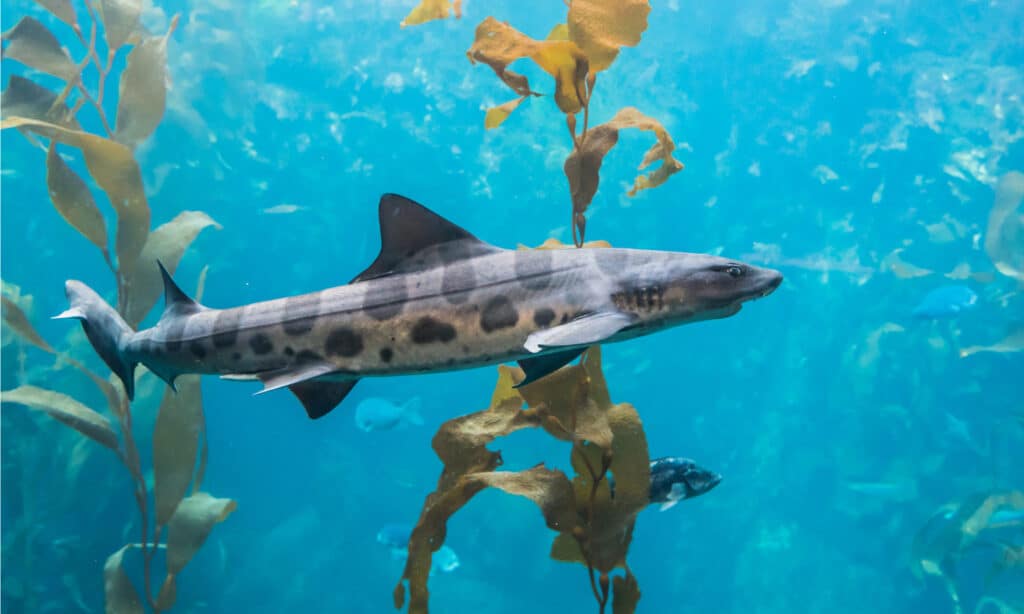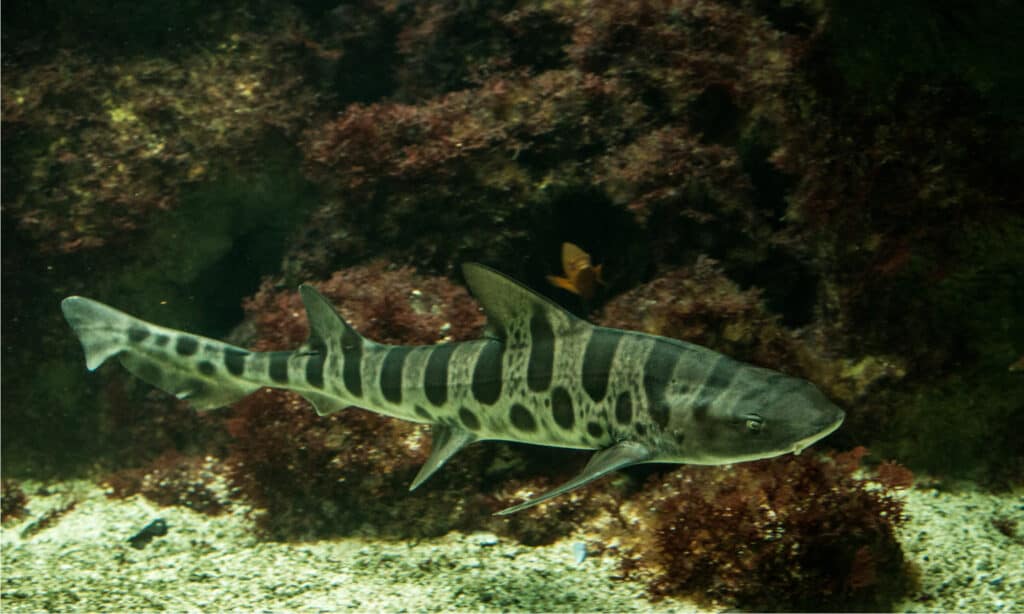Leopard sharks can be described as one of the most beautiful shark species in the world. One reason is that their skin is covered with beautifully colored patterns. These patterns are similar to those we see on leopards.
While there are many remarkable facts about the leopard shark, this article will be discussing where they can be found. Read on to learn where leopard sharks live.
Where Do Leopard Sharks Live?

Leopard sharks prefer to stay in shallow waters.
©David A Litman/Shutterstock.com
Leopard sharks are typically found in the northeastern part of the Pacific Ocean, which includes areas on the west coast of America. This area ranges from the temperate water of Coos Bay, Oregon, to the tropical waters of Mazatlán, Mexico. With this, we can see that despite their narrow habitat range, leopard sharks are highly adaptable to many marine habitats.
However, these sharks prefer to stay in shallow waters like bays and estuaries. They can typically swim near the sea floor of places ranging from intertidal zones to areas of about 13 feet in depth. Despite their love for shallow waters, some leopard sharks have been found in areas as deep as 299 feet.
While a few leopard sharks may feel the urge to be adventurous and would travel several hundreds of miles away from their habitats, most of them are not migratory. The non-migratory ones often stay in the region they were born.
Finally, leopard sharks are found in both cold and tropical water bodies. However, those in cold regions have been found to move to the south during the winter, significantly when the temperature drops below 54°F. This means that they do not enjoy staying in bodies of water with extreme temperatures.
What Do Leopard Sharks Eat?

As carnivores, leopard sharks have a diet that includes crabs, shrimp, and squid.
©SunflowerMomma/Shutterstock.com
The leopard shark is a carnivore, which means that it primarily feeds on animal-based matter. Their diet mainly includes crabs, shrimp, bony fish, clams, fish eggs, and squid. Factors like the location and size of the shark can determine what type of food it eats.
For instance, large adults would eat more significant foods such as fish. On the other hand, juvenile and small adults would eat more miniature food like crabs, clam siphons, fish eggs, and the burrowing, hot dog-shaped fat innkeeper worm.
Are Leopard Sharks Endangered?
The leopard shark does not have any predators except for bigger sharks. However, their population is greatly reduced by factors such as:
- Overfishing by humans
- Dwindling range of its habitat.
Apart from these two factors, the slow growth rate of the fish, the low reproduction rate, and the relatively late age of birthing their first offspring also affect their population growth.
Notwithstanding these factors, the leopard shark has been marked to be of least concern by the International Union for Conservation of Nature (IUCN). Although there are no records of the numbers of leopard sharks left in the world, steps have been taken in recent years to manage those that can be recorded. These steps are envisioned to prevent the species from getting endangered in the future.
Leopard Shark Adaptation

The leopard shark’s mouth can be found on the underside of its body.
©Jiri Hrebicek/Shutterstock.com
Leopard sharks have adapted to living very close to the ocean floor, and this can be attributed to some of the characteristics they possess. One of these characteristics is the lack of a swim bladder which is common to most sharks (the swim bladder is used by fish for buoyancy control). The lack of a swim bladder makes it easy for the leopard shark to stay near ocean floors.
Another adaptation that helps these sharks is the location of their mouth. The leopard shark’s mouth can be found on the underside of its body. The location of the mouth helps it feed or suck in prey that is located on the ocean floor, such as worms.
One of the unique attributes of the leopard shark is the beautifully colored patterns on the leopard shark’s skin. The patterns found on its skin are not only for beautification, they also help the leopard shark to blend well with its surroundings as well as camouflage.
Many other characteristics can help the leopard shark in living around the ocean floor. This includes the possession of a gill for respiration inside the water and possessing a third eyelid to protect their eyes while feeding on their prey.
Are Leopard Sharks Dangerous To Humans?
The simple answer to this is no, leopard sharks are not dangerous to humans. Although generally, sharks are known to attack humans, the leopard shark is an exception. There has only been one recorded leopard shark attack, which wasn’t fatal.
The photo featured at the top of this post is © John Back/Shutterstock.com
Thank you for reading! Have some feedback for us? Contact the AZ Animals editorial team.






